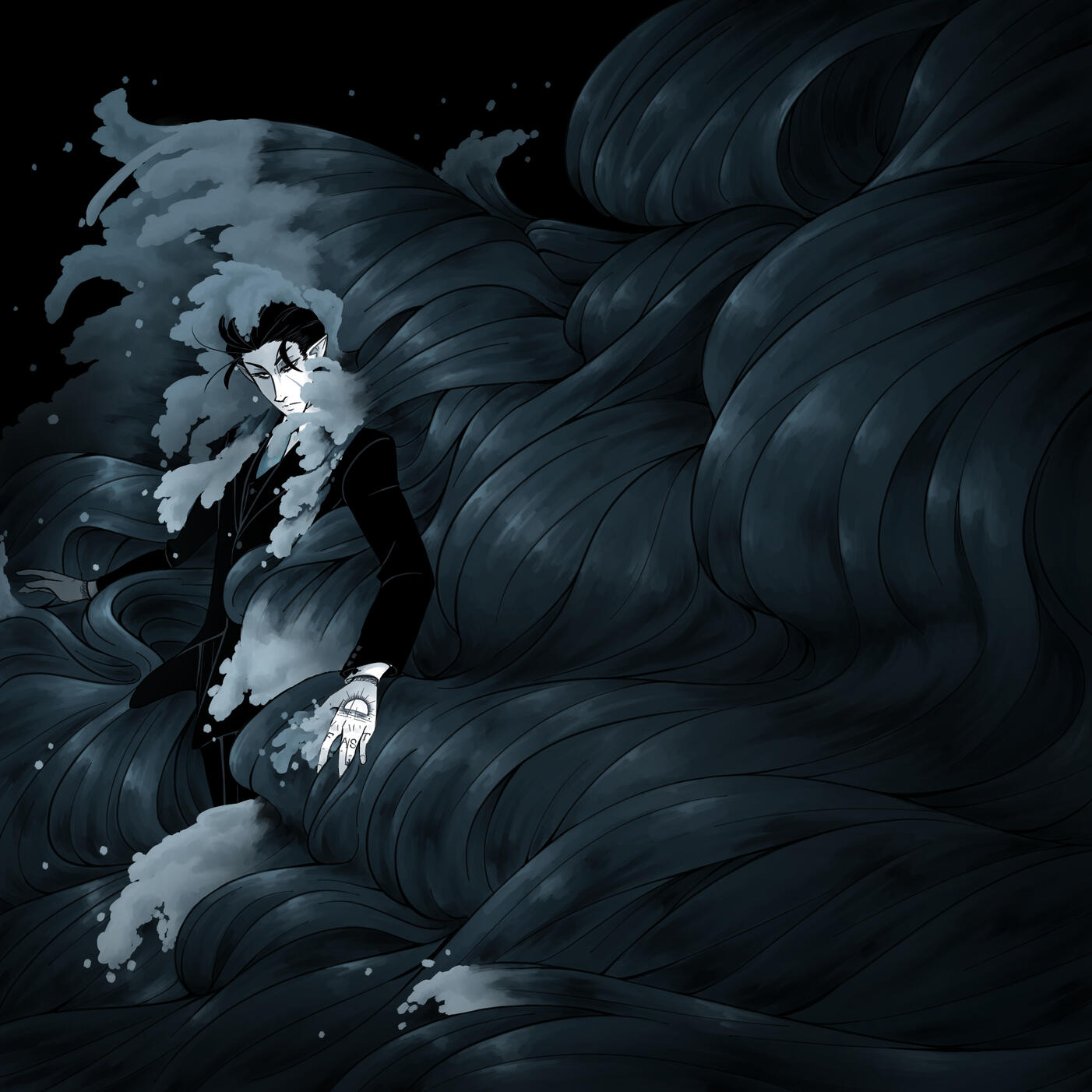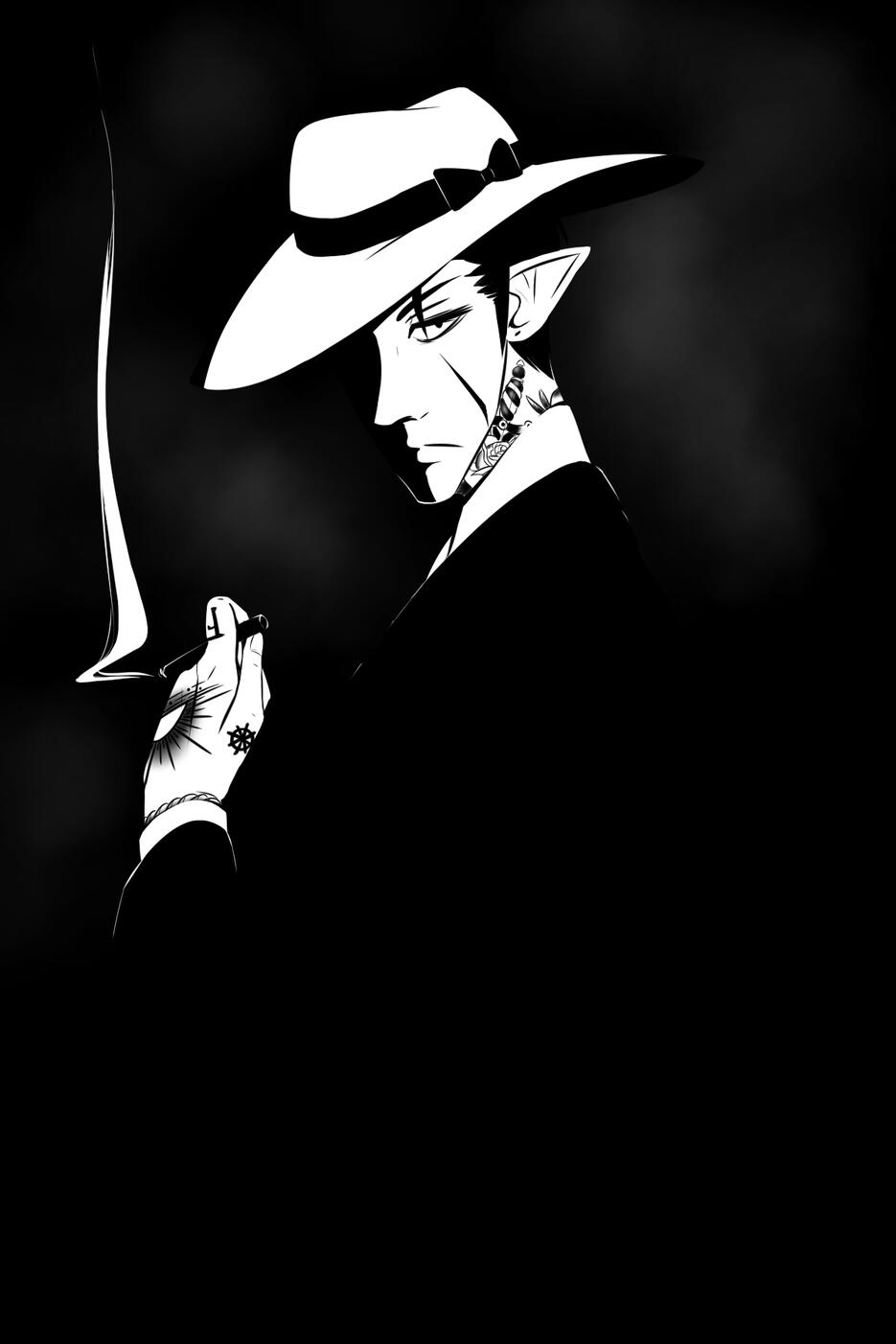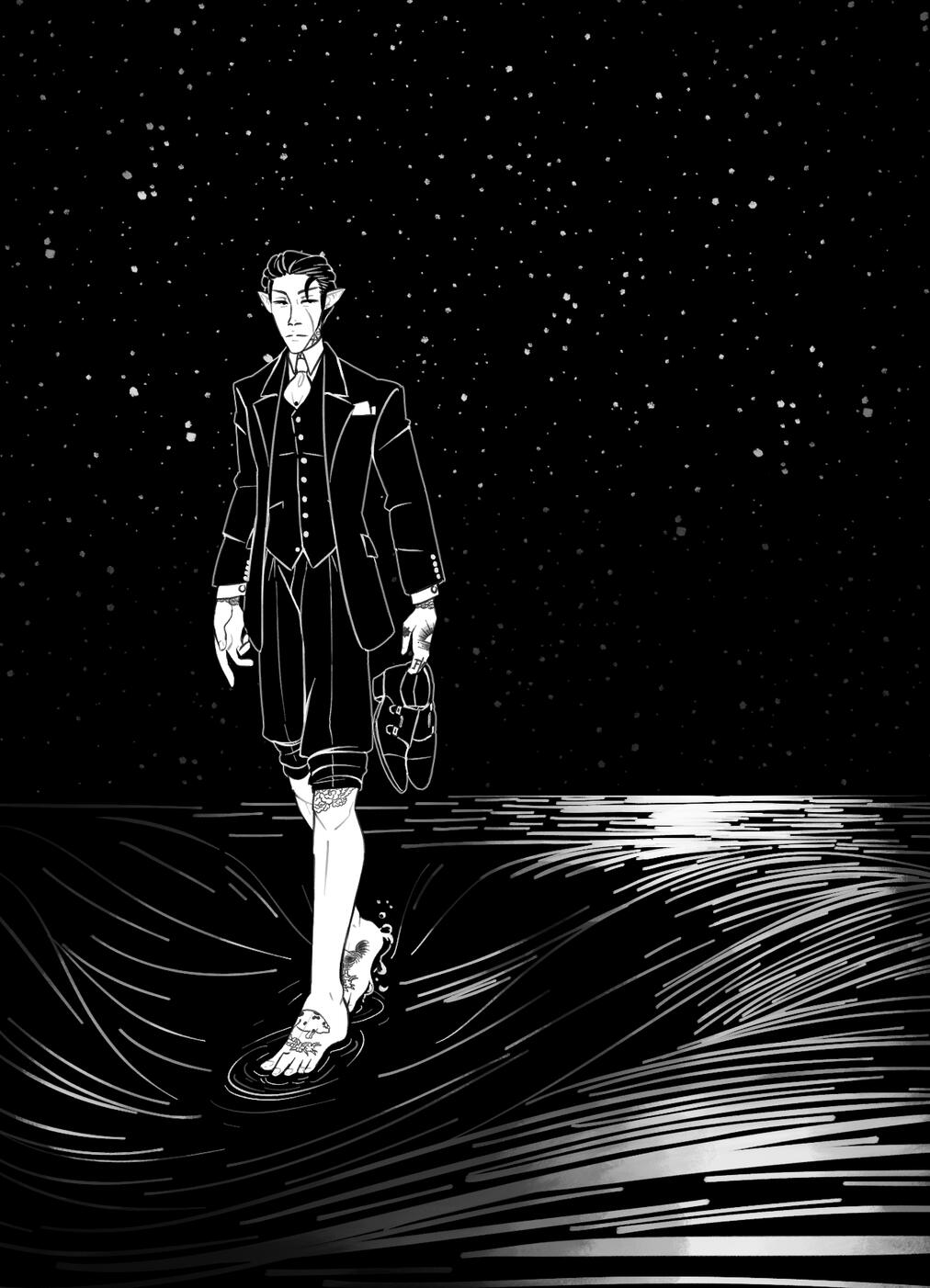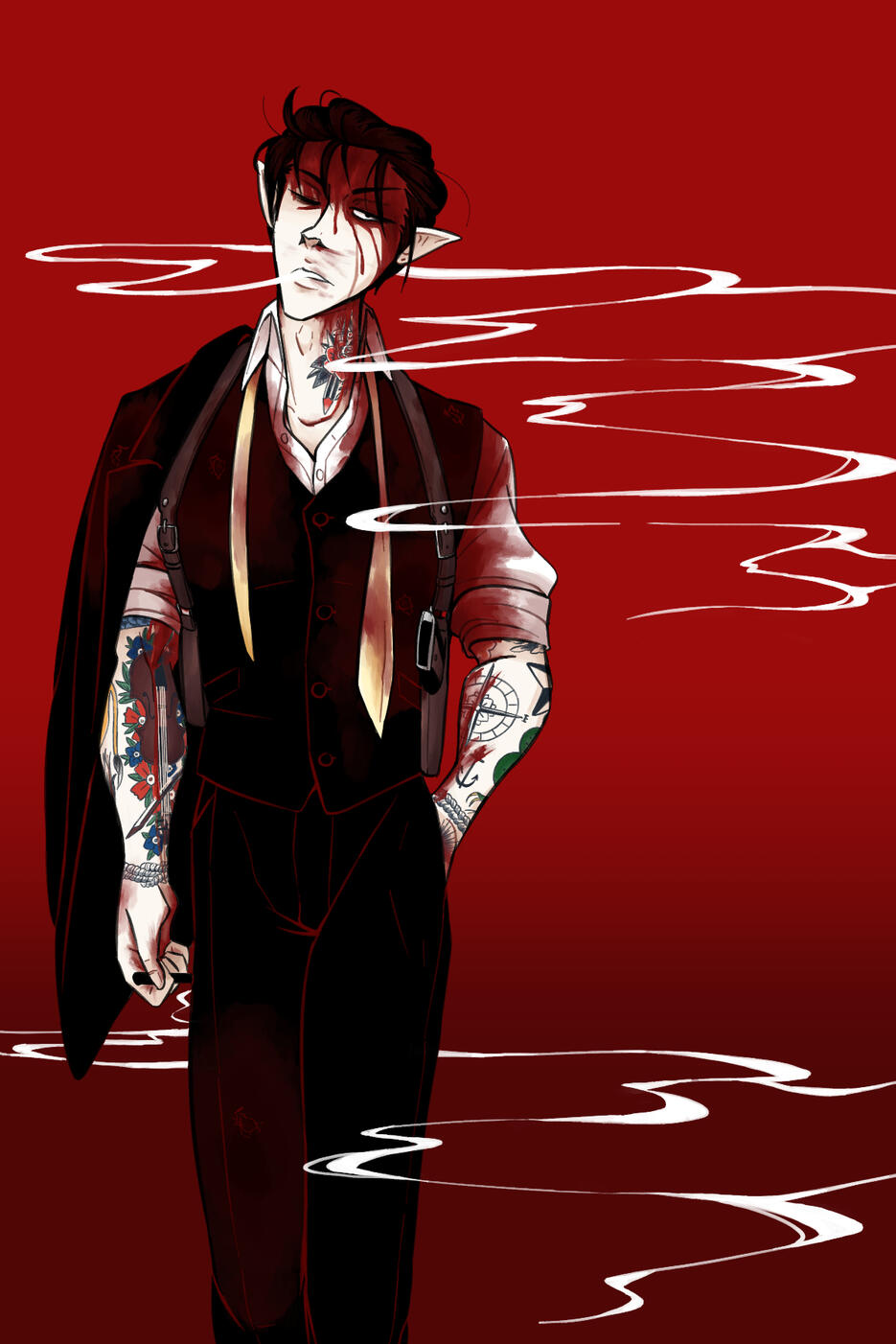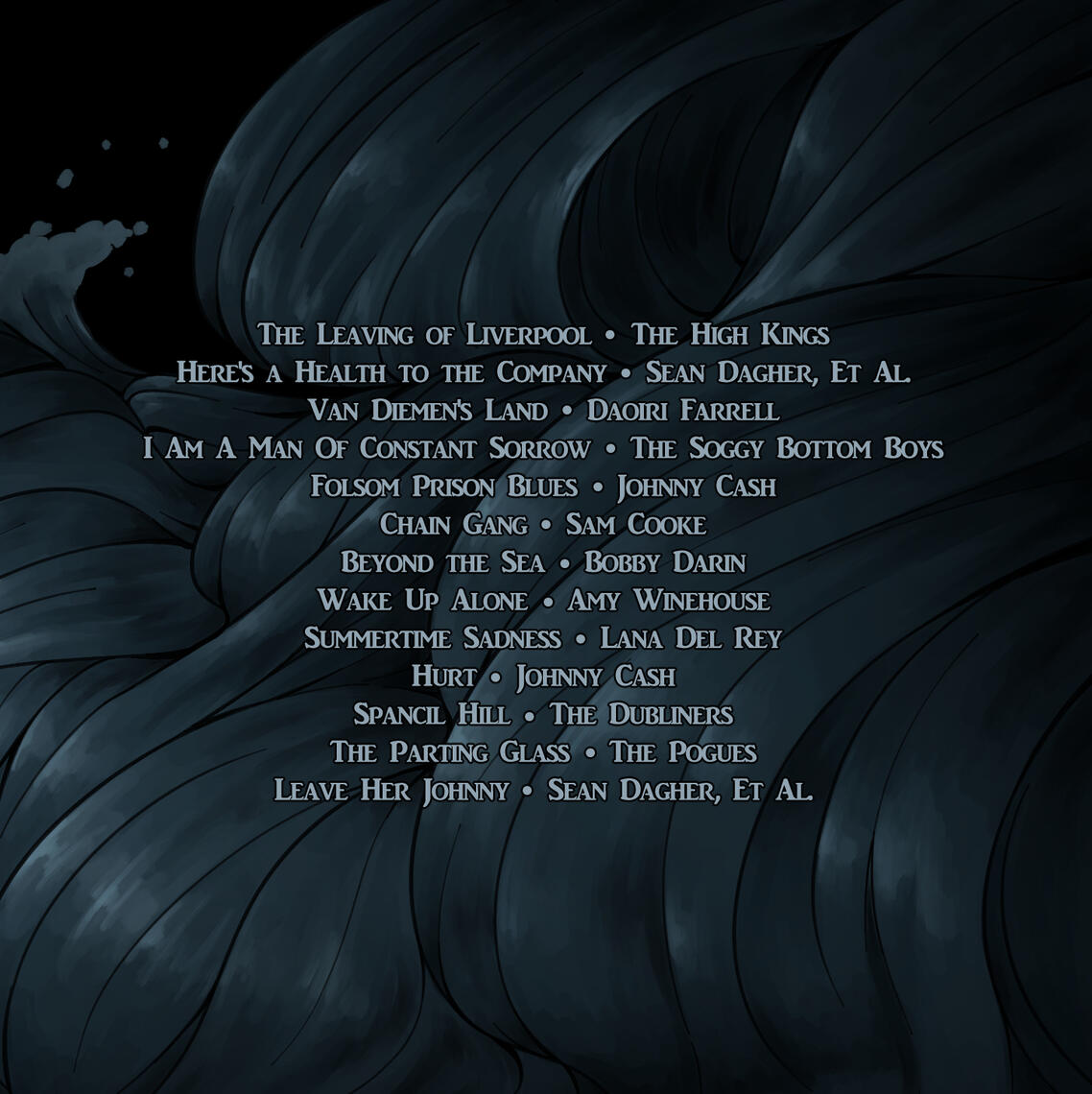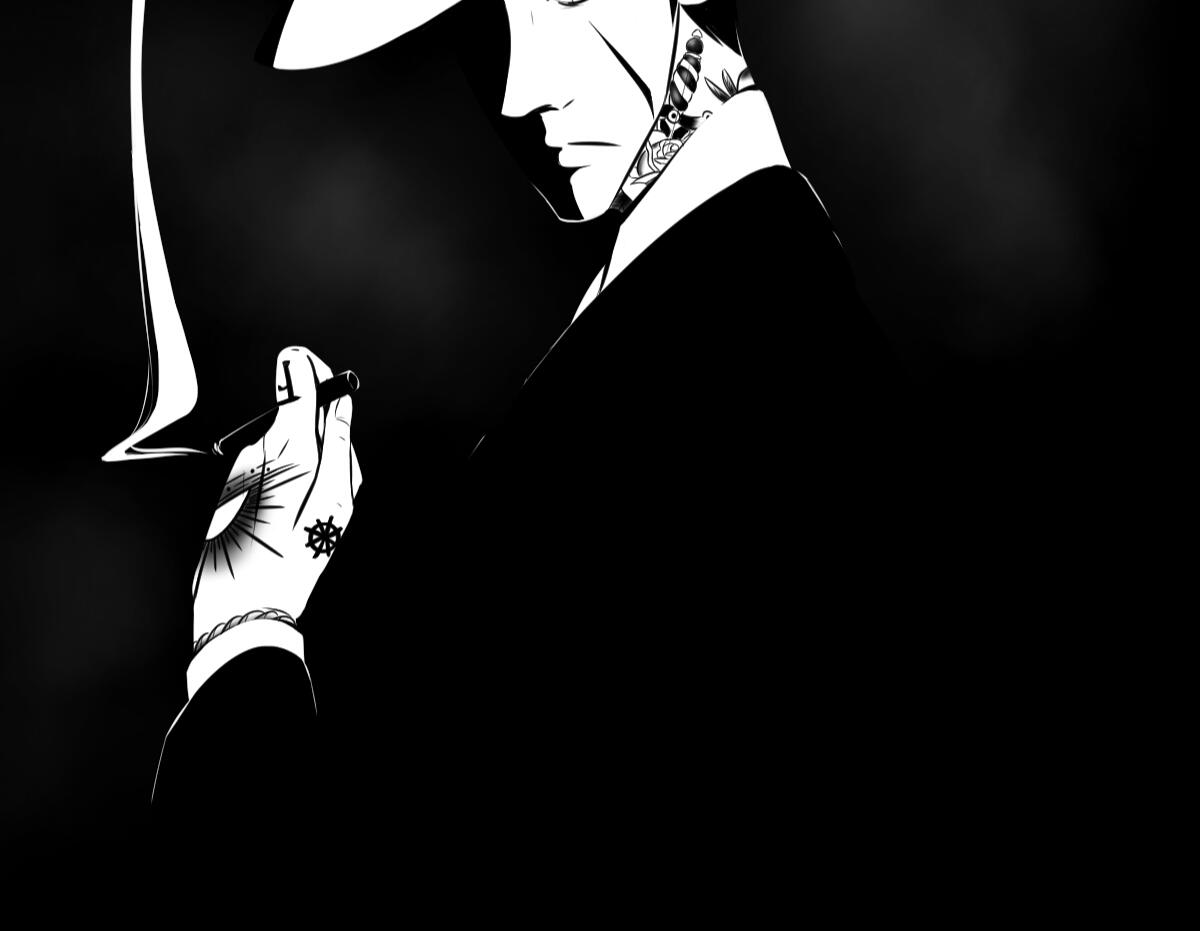
WHEN NO ONE KNEW HIS NAME
Interview with Jonathan Hawkins, The Vampire
New York City, 1999 — On a hot July day in a bustling Manhattan café, journalist Van Daniels interviews Jonathan Hawkins—a dangerous mafia associate and a pop cultural icon called The Vampire. Despite Hawkins' taciturn nature, his face features regularly in tabloids and TV programs, and his deeds are mirrored in works of fiction. He does not speak to the press and has never volunteered any information about himself. All of it based on the rumors that follow him wherever he goes: whispers about the man who melts into shadows and rolls in with the fog—the man who cannot be killed and does not die.The rumors have followed him since he first came ashore in Long Beach, California, in 1919. He has not aged a day since then.The reason for Hawkins' unnatural longevity is unknown—equally so, his reasoning for agreeing to this interview at all. But before Hawkins can get up from their table and vanish back into shadow and fog, Daniels intends to get to the bottom of both mysteries.
WHEN NO ONE KNEW HIS NAME:
INTERVIEW WITH JONATHAN HAWKINS, THE VAMPIREVAN DANIELS, SIMON & SCHUSTER, 2004
[JACKET COPY]
On a sticky July day in 1999, long-time Mafia associate Jonathan Hawkins—also called The Vampire—gave a taped account of his unusually long and varied life.
For eighty years, Hawkins haunted the streets of major cities all across America. He was connected to illegal gambling rings, bootlegging, racketeering, extortion, and most famously, murder. But despite all of this, he was never charged with a crime. Instead, his personal legend expanded, taking up more and more space in the public imagination until he had woven himself into the very fabric of American popular culture. But despite Hawkins’ fame, he remained enigmatic to both investigators and the public at large—until that day in the summer of 1999.
Two weeks later, Jonathan Hawkins disappeared, and has not been seen since.
The veil on one of the twentieth century's greatest mysteries is pulled back as New York Times reporter Van Daniels unwinds thirteen hours of tapes and his experience conducting the first ever—and possibly last—interview with Jonathan Hawkins, The Vampire.
[ABOUT THE AUTHOR]
Van Daniels has a career in journalism spanning over thirty years. Since 1976, he has written for the New York Times Metro desk, reporting on crime and criminal justice. In 1983, he won a George Polk Award for an exposé documenting the involvement of organized crime in constructing the Javitz Convention Center in New York’s West End. Daniels is also the author of Changing of the Guard, which analyzes the rise of the Italian Mafia and its changing role in America’s criminal landscape. Over the course of his career, Daniels has always prioritized accuracy and fairness, while endeavoring to examine the facts from every angle. He is a Brooklyn native and a lifelong fan of the New York Rangers; he has two dogs.
PREFACE
I click the button on my tape recorder sitting on the table between us. The reels begin to turn; the empty one starts to wind the black magnetic tape around itself, like a caterpillar spinning a cocoon of silk. “Okay,” I say. “Interview with Jonathan Hawkins, The Vampire—tape one. Tell me who you are.”
The shadow across from me blinks for the first time in almost seven seconds. Since his eyes haven’t left my face for longer than it took him to order or receive coffee, I’ve started counting. I’ve since learned that the average person blinks every three to four seconds, which accounts for how uncomfortable it felt to hold his gaze. For another six seconds, he stares at me in silence; then he blinks again, and says, “I’m an associate of John Junior, current boss of the Gambino crime family.”
That single admission is more of a confession than anyone’s ever gotten out of him on record. It’s a low bar, but clearing it still sparks a thrumming current of excitement in my chest—but I tamp down on the celebratory impulse. I laugh wryly under my breath. “That’s an understatement, don’t you think?”
He just stares at me.
At the time of this interview, it is July 12, 1999, and we sit at a little table tucked into a corner of Balthazar in SoHo. Late morning sunlight streams in through the window behind me, shining bright in the big mirrors on the far wall of the restaurant. The ceiling fans work overtime to circulate the air, but the midsummer heat and humidity still hang heavy. From when its doors open at 7 a.m. to when they close at 1 a.m., Balthazar is always packed, and today is no exception. The din of conversation and clattering tableware echoes through the spacious dining room as waitstaff weave expertly between close-spaced tables, full trays held aloft over diners’ heads.
Readers will be familiar with Jonathan Hawkins. Even if you don’t pay much attention to the news, you know him. You’ve seen reflections of him in practically every artistic medium—from Raymond O’Connell’s 1962 novel Silent City and Martin Scorsese’s 1992 adaptation of it; to the 1974 ahistorical yet chart-topping single “The Night LA Died”; to the general preponderance of cold-blooded, tight-lipped men in black as synecdoche for criminal elements across all genres for the past thirty years. You’ve seen the tabloids at newsstands and grocery stores shouting at you the rumors that follow him through the underworld in hushed whispers. The man who can see in the dark. He drinks blood, and flies through the air, and flattens himself into a shadow. He controls the weather; he comes back from the dead. He doesn’t age.
You know The Vampire—if just because that last rumor, at least, is true.
Since the 1920s, every single photograph of Jonathan Hawkins has looked exactly like the man sitting across from me: lean and pale, with slicked black hair and black eyes; he wears a crisp white shirt and a black Italian-cut suit. Just like the old newspaper photos, he is stark black and white in person—except for the tattoos. His knuckles read HOLD FAST in dark blue ink. On his left hand, there is a sun rising from a deep blue ocean, and below the letters, a small crown on his ring finger, along with a ship’s wheel on his thumb; the back of his right hand bears a lighthouse, and the letters O and L are respectively subtitled with an Irish harp and what I’ve since learned is the liver bird—the symbol of Liverpool, England. A coil of rope circles each wrist, just barely peeking out from under the cuffs of his shirt, while some foliage and the hilt of a dagger rise above his collar. There is a thin scar climbing up his cheek on his left side, stretching from his jaw to almost his eye. His ears are unusually oblong and taper into a point.
“Don’t know what you want me to say,” he says at last.
I’ve sat across from a few dangerous men in my career, but none have made me as uneasy as Hawkins. Newsprint fails to capture the coldness of his eyes. Though intense, they seem completely lusterless, resulting in a look I can only describe as dead. They feel eerie and unsettling to have focused on me—like being submerged in a deep, dark lake in the middle of winter.
But I don’t let my discomfort show. “Okay. Let me ask you about your reputation. You’ve been a popular topic in the media for more than thirty years. Films; TV; newspapers. I’ve even recently written a book about—”
“I don’t know about any of that,” Hawkins flatly interjects. “I don’t read about myself.”
That’s an interesting claim—and a transparently false one. Everyone knows about The Vampire; that has to include The Vampire himself. “You watch a lot of movies, right? You never saw Silent City?”
“Sure I did; but that wasn’t me.”
“Jack de Vito is pretty clearly based on you, though.”
He shrugs one shoulder in a gesture so minimal that it barely counts as movement, and hums a single low note of perfunctory acknowledgement.
That claim strikes me as additionally false, because I strongly suspect he is aware of the book I’ve written about him, and that it was the impetus for our current meeting. But that isn’t important at this juncture. I press on: “So you don’t read about yourself; why not?”
He blinks; a half-second of relief from the chill of his gaze. “Why would I?”
Hawkins speaks in a low monotone that feels discordant against the buoyancy of his accent. Ts and THs at the start of syllables come out more like Ds, and he omits them nearly completely from ends. His K and hard C sounds rattle around in his throat; his short OOs drag out longer and rounder than in more southerly dialects. My sounds more like me. A full thirty years before Frank Sheeran would be given the same nickname, Jonathan Hawkins was getting called The Irishman by his Jewish and Italian mob associates. Of course, The Vampire ended up being the nickname that stuck.
“Some people like the attention.”
“I don’t.”
This doesn’t surprise me. Despite eighty years of criminal activity, Jonathan Hawkins remains mysterious because he doesn’t talk about himself, and no one else talks about him either. He has been known to state and federal officials since the dawn of his career as Los Angeles gang boss Charlie Prinz’s right hand-man in the 1920s—but he has never been charged with a crime. Some of this can be attributed to all of the normal difficulties that dog organized crime investigations: police corruption, witness tampering, and oaths of silence. The last of these has been significantly weakened since the 1968 legalization of wiretapping; but not as far as Hawkins is concerned. Informants with few compunctions about implicating other criminals consistently deny seeing Hawkins participate in illegal activities and refuse to help law enforcement entrap him in any. In his 1951 memoir reflecting on his time as a prohibition agent in Los Angeles, Elias Vanderson describes informants’ reluctance to discuss Hawkins:
When Rabinowicz was asked who had given the order to have Eller killed, he grew very pale and silent. Looking away from us, he said he didn’t remember. [Detective Roger James] reminded him that his leniency deal with the DA’s office was contingent on giving up his co-conspirators. But he only clenched his jaw and refused to say anything else. He had given up four men, including his own flesh-and-blood brother. But he wouldn’t give up Jonathan Hawkins.This reluctance was frustratingly typical for both Prinz men and the civilian residents of Boyle Heights. Not a soul was willing to say Hawkins’ name in the presence of a federal agent. No one had ever seen him anywhere; no one had ever spoken to him about anything. A [Prinz gang] associate we brought in one time was frank with us: he told us outright that chasing Hawkins was a waste of our time, because there wasn’t anyone foolish enough to rat on him. When I asked him why, he said: “You don’t mess around with stuff you don’t understand.”And he was right: even after Hawkins disappeared in 1938, no one would talk about him. It was like they were worried about summoning him from wherever he was hiding—or wherever he was buried.
But that hasn’t saved Hawkins from becoming an object of popular fascination. The newspapers talked about him, especially during his six-month gang war with the LA Mafia in 1938; and as the decades stretched on and journalists and investigators put together that the ghost haunting their town was the same man who had set LA ablaze, the spotlight on him only grew brighter. He spent the 1920s, ‘30s, and ‘40s as a regional West Coast bogeyman; but by the 1970s, people all over the country were familiar with him.
Part of this can be attributed to the aforementioned 1962 crime novel, Silent City. Local presses in California and Nevada had been publishing crime serials haunted by Hawkins for decades; but City’s multiple sold-out print editions disseminated the image of a laconic man in black among a wider audience. Combined with a blossoming journalistic interest in linking the disjointed segments of his career, Jonathan Hawkins was quickly identified as the real-life inspiration for the novel’s iconic antagonist, Jack de Vito. From there, a minor literary craze started, and by the 1980s, Hawkinsian characters had become a staple of the crime genre. After the underworld whispers about him surfaced in newspapers in the 1970s, the pulp fiction presses established the niche of supernatural crime—a synthesis of crime fiction and gothic horror; a funhouse reflection of the rumors that made hardened criminals shut up and look the other way. As a result, today Hawkins feels just as at home beside Count Dracula and Nosferatu in the pop cultural landscape as he does beside Tony Montana and Vito Corleone.
Of course, this public interest does not end with the media. As Carol Morado writes in Hybristophilia: Male Killers and the Women Who Love Them, as long as Hawkins has appeared in newspapers, fascination has always followed. His elegant features and deep, dark eyes—to use Morado’s words, “smoldering in the black and white of newsprint like a Gaelic Rudolph Valentino”—won him admiration from appreciators of male beauty as far back as the 1930s. Morado identifies what she calls “fan interest” during each period and locale where he appeared in the papers. Following the deluge of media about him in the 1960s and ‘70s, the following decades saw fan clubs arise dedicated to Hawkins, the exciting and uncertain nature of him and his crimes, and his good looks. Morado cites evidence of at least fifteen active clubs with three or more members in 1987. Since the advent of the internet, myriad websites dedicated to Hawkins are now just a click away, ranging from libraries of photos and transcribed newspaper clippings, to impassioned essays and logs of “evidence” that he is everything from the Antichrist to the gunman responsible for the JFK assassination.
Whatever his aversion to it, Jonathan Hawkins has achieved genuine celebrity. He is not the first criminal to have done this: Al Capone actively courted the press, while Colombo Family don Joe Colombo publicly campaigned against Italian-American discrimination; and both of them, along with others like Bugsy Siegel and Charlie Prinz, ran in circles that included some of the most famous people in America at the time. But Hawkins’ fame eclipses them all. After a time in the spotlight, each of them exited the stage—whether to a federal penitentiary, retirement brought on by a life-altering assassination attempt, or an early grave. While Hawkins has often temporarily vanished, he has always returned for an encore.
Nevertheless, Hawkins’ claim that he dislikes attention invites a question about why he’s talking to me on the record. But I set that aside for the time being. “You were a sailor in a past life,” I say. “Why did you choose to come on land?”
Again, he stares at me in unblinking silence. I notice now that he is incredibly still—he barely even looks like he’s breathing. Maybe his uncomfortable likeness to a wax statue is what has me so on-edge. “Sailing wasn’t what it used to be,” he says, finally giving me a sign that he’s alive. “The oceans were getting smaller; the ports wanting more papers. Harder to find work.”
The earliest mention of Jonathan Hawkins in the United States is at the port of Long Beach, Calif., on March 13, 1919—just four months after the conclusion of World War I. He arrived on the Kenilworth, a cargo liner then owned by the Dalgliesh Steam Shipping Company. According to the port papers, he is listed as an able seaman and part of the ship’s crew. There is no record of him going back out to sea aboard the Kenilworth or any other vessel.
“You needed money, then.”
“No; I liked sailing,” he says, as if those things are mutually exclusive. “It wasn’t like it had been.” He pauses. “It was harder to disappear.”
“What do you mean?”
Again, he makes an almost imperceptible shrug. “Arrive in a port where no one knows your name or face. Enjoy it for a while. Then board a ship bound for somewhere else.” He blinks slowly. “It was a good life while it lasted—coming and going.”
“So why a gang?”
Hawkins is quiet for a moment. Something about his silence strikes me as pensive—as if he’s considering either my question or how to describe his answer. In the meantime, he continues to stare at me, his eyes digging into my skull like an awl. “Seemed like the next best thing, if I couldn’t be a seaman.”
“And you felt like you couldn’t do that anymore because the oceans had shrunk?”
He blinks; and since he doesn’t correct me, I take it as affirmation.
World War I saw the advent of many technologies that would go on to become commonplace in civilian life. One example of this is radio, which was in early use aboard the warships and submarines patrolling the Atlantic, enabling quick communication between both land and other vessels. Another example was tighter restrictions around the documents required for someone to exit or enter a country; although they were initially implemented for wartime security reasons, they remained in place after the fighting had ended. There’s certainly an argument to be made that the world and its seas seemed smaller after the first truly global conflict.
And this moment was apparently where Jonathan Hawkins, the unknown seaman, died, and Jonathan Hawkins, The Vampire, was born.
“How long were you a sailor?” I ask.
His eyes leave my face for the first time since the waiter brought his coffee. They flick sideways in thought before snapping back to me. “About six score.”
One hundred twenty years.
Quickly, I do the math in my head, adding that to his time since coming ashore. “So you’re claiming to be two hundred years old?” I ask, a strangled note of incredulity slipping into my voice.
“Born in 1781.”
The impulse to laugh rises in my chest, but I swallow it back. The claim is just too ridiculous. I look at the man across from me in his tailored suit—complete in his modernity—and my rational mind rejects it out of hand. “And you expect me to believe that?”
Hawkins doesn’t say anything for a moment. He grips his cup by its body—hooking two fingers through the handle—and takes a drink of coffee. As the rim rises to obscure his face, his eyes remain fixed on mine. He sets the cup back in its saucer. “What do you want to know?”
The question flashes through my brain like a warning shot. His low, droning rumble is pierced by a faint note of impatience—maybe even irritation. I’m suddenly acutely aware of myself, my words, and my tone of voice. All at once, I realize the delicacy of the situation.
At the time of this interview, the final manuscript for my book about Jonathan Hawkins was in the publisher’s hands, and I was doing the promotional press circuit at the time. A couple days after I’d been on Larry King Live to talk about its release, I got a call to my desk at the New York Times office.
Jonathan Hawkins was on the line, asking if I wanted to interview him.
Obviously, I did; but just as obviously, he had something he wanted to tell me. I wasn’t sure what it was; but the sudden break in his eighty-year silence signaled it was something of great personal importance. I thought he would be willing to stomach some rough handling to get it out there—but something about him gives me the sense that he might be moments from walking. His question is a warning, reminding me that we are meeting entirely at his pleasure.
Maybe it’s a bluff to coerce me into accepting impossible claims without question. But on that July day in Balthazar, my choice is clear. I’ve written an entire book about Jonathan Hawkins. I’ve gone through the old newspaper archives; I’ve done interviews with people who knew him decades ago. I know he’s at least a hundred years old, and I’ve verified that he hasn’t aged a day in all that time. If I’m going to continue with this interview, I’ll have to accept some level of impossibility, because the basic facts about Hawkins are impossible.
For possibly the first time, it really sets in that I’m interviewing The Vampire. More than just hearing about a century of gangster lore from the man himself, I have the opportunity to learn who and what he really is. And by giving me an opportunity to correct myself, he has confirmed my impression that this meeting is important to him.
I resolve to hear whatever he says to me with an open mind—no matter how absurd.
Again, I do the math in my head. “So that makes you—two hundred-eighteen years old?”
Hawkins seems to accept this as assurance that I got his meaning. I don’t notice the fine knifepoint in his gaze until it relaxes back into that familiar awl. He blinks slowly. “Maybe,” he says. “I haven’t been counting.”
GALLERY
PLAYLIST
ABOUT
When No One Knew His Name is an illustrated story within a story: it is the story of Hawkins' long and varied life nested within the story of Daniels' encounter with this unusual man. The text is presented as the in-universe nonfiction book Daniels went on to write based on the transcript of his interview with Hawkins, whose descriptions are intercut with Daniels' outside research to provide greater context or alternate perspectives to the reader.When No One Knew His Name is a low-fantasy pastiche of Anne Rice's 1976 novel Interview with The Vampire, featuring heavy elements of historical and crime fiction, and themes of alienation and ennui in the face of an uncertain future.
marrrow is a writer-artist from Southern California. He likes goth rock, boba tea, and staring out over the expanse of the Pacific Ocean while marveling at the smallness of a single human lifetime.
